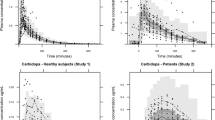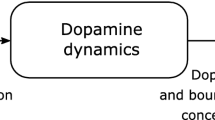Abstract
Purpose
Levodopa is the reference treatment for Parkinson’s disease. However, after several years of treatment, dyskinesia may occur and strategies to overcome this side effect still need to be explored. We identified a unique population pharmacokinetic/pharmacodynamic model in Parkinson’s disease to investigate the relationship and dissociability of motor response and dyskinesia.
Methods
Thirty parkinsonian patients (Hoehn and Yahr stages 3–4), treated with levodopa and suffering from peak-dose dyskinesia, were included in a prospective open-label study. They received a single dose of levodopa equal to 150 % of their usual daily dose. Blood samples, motor evaluations (UPDRS III scale) and peak-dose dyskinesia (Goetz scale) were examined after administration. A population pharmacokinetic/pharmacodynamic (PK/PD) model was developed using NONMEM software.
Results
Pharmacokinetic analysis identified a one-compartment model with the following parameter values [bootstrap 95 % CI]: absorption rate constant (KA) 1.86 1/h [1.08–3.25], clearance 36.6 L/h [31.3–42.8], and volume of distribution 42.9 L [34.3–52.3]. Between-subject variability was 122 % [71–183] and 38 % [26–47] for KA and clearance, respectively. Residual variability was 1120 μg/L [886–1290]. UPDRS III and dyskinesia were best described with an effect compartment and similar KE0 values of 1.37 1/h [1.01–1.77]. For UPDRS III, the E0, EC50, Emax, and Hill coefficient were 31.4 [28.4–35.3], 1410 μg/L [1200–1700], 0.72 [0.71–0.75], and 4.26 [3.20–5.58], respectively. For dyskinesia, the EC50 and Emax were 6280 μg/L [3420–37,900] and 17.9 [12.3–80.8], respectively. Residual variability was 3.15 [2.75–3.53] for UPDRS III and 2.66 [1.94–3.51] for dyskinesia. No covariates influenced the parameters.
Conclusions
In patients treated with levodopa and suffering from dyskinesia, the motor response and dyskinesia have close onsets and duration effects. Maximal motor response tends to be inevitably associated with dyskinesia.



Similar content being viewed by others
References
Schrag A, Quinn N (2000) Dyskinesias and motor fluctuations in Parkinson’s disease. A community-based study. Brain 123:2297–2305
Rajput AH, Fenton ME, Birdi S, Macaulay R, George D, Rozdilsky B, Ang LC, Senthilselvan A, Hornykiewicz O (2002) Clinical-pathological study of levodopa complications. Mov Disord 17(2):289–296
Hauser RA, Rascol O, Korczyn AD, Jon Stoessl A, Watts RL, Poewe W, De Deyn PP, Lang AE (2007) Ten-year follow-up of Parkinson’s disease patients randomized to initial therapy with ropinirole or levodopa. Mov Disord 22(16):2409–2417
López IC, Ruiz PJ, Del Pozo SV, Bernardos VS (2010) Motor complications in Parkinson’s disease: ten year follow-up study. Mov Disord 25(16):2735–2739
Bastide MF, Meissner WG, Picconi B, Fasano S, Fernagut PO, Feyder M, Francardo V, Alcacer C, Ding Y, Brambilla R, Fisone G, Jon Stoessl A, Bourdenx M, Engeln M, Navailles S, De Deurwaerdère P, Ko WK, Simola N, Morelli M, Groc L, Rodriguez MC, Gurevich EV, Quik M, Morari M, Mellone M, Gardoni F, Tronci E, Guehl D, Tison F, Crossman AR, Kang UJ, Steece-Collier K, Fox S, Carta M, Angela Cenci M, Bézard E (2015) Pathophysiology of L-dopa-induced motor and non-motor complications in Parkinson’s disease. Prog Neurobiol. doi:10.1016/j.pneurobio.2015.07.002.
Hely MA, Morris JG, Reid WG, Trafficante R (2005) Sydney multicenter study of Parkinson’s disease: non-L-dopa-responsive problems dominate at 15 years. Mov Disord 20(2):190–199
Fahn S (2000) The spectrum of levodopa-induced dyskinesias. Ann Neurol 47(4 Suppl 1):S2–S9 discussion S9-11.
Manson A, Stirpe P, Schrag A (2012) Levodopa-induced-dyskinesias clinical features, incidence, risk factors, management and impact on quality of life. J Parkinsons Dis. 2:189–198. doi:10.3233/JPD-2012-120103
Contin M, Riva R, Martinelli P, Cortelli P, Albani F, Baruzzi A (1994) Longitudinal monitoring of the levodopa concentration-effect relationship in Parkinson’s disease. Neurology 44:1287–1292
Mouradian MM, Heuser IJ, Baronti F, Fabbrini G, Juncos JL, Chase TN (1989) Pathogenesis of dyskinesias in Parkinson’s disease. Ann Neurol 25(5):523–526
Nutt JG, Woodward WR, Carter JH, Gancher ST (1992) Effect of long-term therapy on the pharmacodynamics of levodopa. Relation to on-off phenomenon. Arch Neurol 49(11):1123–1130
Contin M, Riva R, Martinelli P, Albani F, Baruzzi A (1997) Relationship between levodopa concentration, dyskinesias, and motor effect in parkinsonian patients: a 3-year follow-up study. Clin Neuropharmacol 20:409–418
Goetz CG, Stebbins GT, Shale HM, Lang AE, Chernik DA, Chmura TA, Ahlskog JE, Dorflinger EE (1994) Utility of an objective dyskinesia rating scale for Parkinson’s disease: inter- and intra-rater reliability assessment. Mov Disord 9:390–394
Kalia LV, Lang AE (2015) Parkinson’s disease. Lancet 386:896–912
Wikberg T (1991) Simultaneous determination of levodopa, its main metabolites and carbidopa in plasma by liquid chromatography. J Pharm Biomed Anal 9:167–176
Beal S, Sheiner LB, Boeckmann A, Bauer RJ (2009) NONMEM user’s guides (1989–2009). Icon Development Solutions, Ellicott City, MD
Karlsson MO, Jonsson EN, Wiltse CG, et al. (1998) Assumption testing in population pharmacokinetic models: illustrated with an analysis of moxonidine data from congestive heart failure patients. J Pharmacokinet Biopharm 26:207–246
Mould DR, Upton RN (2013) Basic concepts in population modeling, simulation, and model-based drug development-part 2: introduction to pharmacokinetic modeling methods. CPT Pharmacometrics Syst Pharmacol 2:e38. doi:10.1038/psp.2013.14
Brendel K, Comets E, Laffont C, et al. (2006) Metrics for external model evaluation with an application to the population pharmacokinetics of gliclazide. Pharm Res 23:2036–2049
Zhang L, Beal SL, Sheiner LB (2003) Simultaneous vs. sequential analysis for population PK/PD data II: robustness of methods. J Pharmacokinet Pharmacodyn 30:405–416
Holford N, Heo Y-A, Anderson B (2013) A pharmacokinetic standard for babies and adults. J Pharm Sci 102:2941–2952
Jorga K, Banken L, Fotteler B, et al. (2000) Population pharmacokinetics of levodopa in patients with Parkinson’s disease treated with tolcapone. Clin Pharmacol Ther 67:610–620
Troconiz I, Naukkarinen T, Ruottinen H, et al. (1998) Population pharmacodynamic modeling of levodopa in patients with Parkinson’s disease receiving entacapone. Clin Pharmacol Ther 64:106–116
Dietz M et al. (2001) Levodopa pharmacokinetic-pharmacodynamic modeling and 6-[18F]levodopa positron emission tomography in patients with Parkinson’s disease. Clin Pharmacol Ther 70:33–41
Nutt JG, Holford N (1996) The response to levodopa in Parkinson’s disease: imposing pharmacological law and order. Ann Neurol 39:561–573
Author information
Authors and Affiliations
Corresponding author
Electronic supplementary material
ESM 1
(DOCX 87 kb)
Rights and permissions
About this article
Cite this article
Simon, N., Viallet, F., Boulamery, A. et al. A combined pharmacokinetic/pharmacodynamic model of levodopa motor response and dyskinesia in Parkinson’s disease patients. Eur J Clin Pharmacol 72, 423–430 (2016). https://doi.org/10.1007/s00228-016-2034-0
Received:
Accepted:
Published:
Issue Date:
DOI: https://doi.org/10.1007/s00228-016-2034-0




